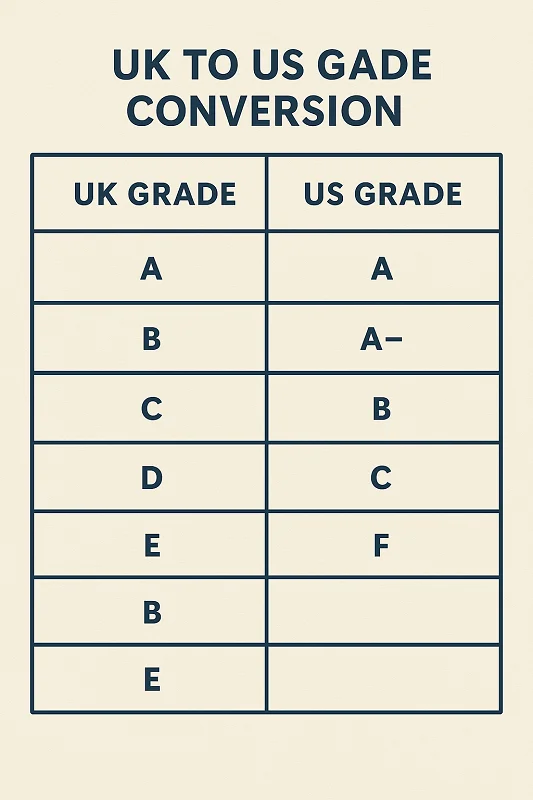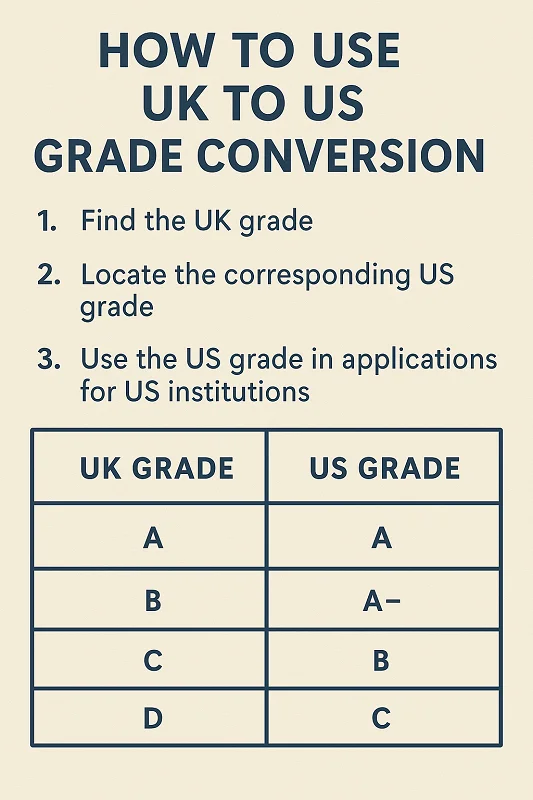How to Convert UK Grades to US Grades
Common Conversion Tables
UK Grade | UK Percentage | US Letter Grade | US GPA |
First Class | 70-100% | A | 3.7-4.0 |
2:1 | 60-69% | B+/A- | 3.3-3.7 |
2:2 | 50-59% | B/B+ | 2.7-3.3 |
Third Class | 40-49% | C+/B- | 2.3-2.7 |
Pass | 35-39% | C | 2.0-2.3 |
Step-by-Step Conversion Guide
- Identify your UK grade classification (First, 2:1, 2:2, etc.)
- Find the equivalent percentage range for your classification
- Match the percentage to the US conversion table
- Apply the corresponding US letter grade and GPA
- Consider institutional variations in conversion policies
Challenges and Considerations
Grade inflation differences: UK grading tends to be more stringent than US grading, making direct conversion complex.
Institutional policies: Different US universities may have varying conversion standards and requirements.
Subject-specific variations: Some academic disciplines may have different conversion expectations or standards.
UK to US GPA Conversion
Degree Class to GPA Mapping
Undergraduate Conversions:
- First Class Honours: 3.7-4.0 GPA
- Upper Second (2:1): 3.3-3.7 GPA
- Lower Second (2:2): 2.7-3.3 GPA
- Third Class: 2.3-2.7 GPA
Postgraduate Conversions:
- Distinction: 3.7-4.0 GPA
- Merit: 3.3-3.7 GPA
- Pass: 2.7-3.3 GPA
Undergraduate Grade Conversion Examples
Example 1: A student with a 2:1 degree (65% average) would typically convert to a 3.5 GPA.
Example 2: A First Class degree (75% average) would convert to approximately 3.8-4.0 GPA.
Example 3: A 2:2 degree (55% average) would convert to roughly 3.0 GPA.
Postgraduate Grade Conversion Examples
Master’s with Distinction (72% average) = 3.8 GPA Master’s with Merit (65% average) = 3.5 GPA Master’s Pass (55% average) = 3.0 GPA
Importance of Accurate Grade Conversion
Impact on University Admissions
Accurate grade conversion directly affects:
- Admission eligibility to competitive programs
- Program placement and academic standing
- Transfer credit recognition and acceptance
Scholarship and Funding Eligibility
Many scholarships require minimum GPA thresholds:
- Merit-based scholarships often require 3.5+ GPA
- Graduate assistantships may require 3.0+ GPA
- Academic honors recognition depends on accurate conversion
Employment and Credential Recognition
Employers and professional organizations rely on accurate grade conversion for:
- Job application screening and candidate evaluation
- Professional licensing and certification requirements
- Career advancement and promotion considerations
Tips for UK Students Applying to US Universities
Preparing Academic Transcripts
Request official transcripts from your UK institution with detailed grade breakdowns and percentage scores.
Include degree classification and final overall percentage on all academic documents.
Provide context about your institution’s grading standards and academic reputation.
Effectively Highlighting UK Grades
Emphasize achievement context: Explain that UK First Class degrees are awarded to only 20-30% of students.
Include class rankings if available and favorable to your application.
Highlight relevant coursework and academic projects that demonstrate your capabilities.
Common Mistakes to Avoid
- Over-inflating grades during self-conversion attempts
- Ignoring institutional requirements for professional transcript evaluation
- Failing to provide context about UK grading standards
- Assuming universal conversion across all US institutions


